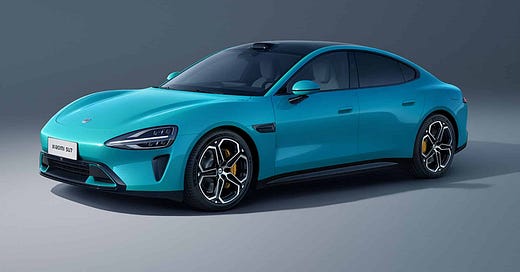Summary
Xiaomi’s Electrifying Leap: How a Smartphone Giant Became a Leader in EVs
Battery Industry Pulse: Weekly Roundup.
Welcome back to another edition of my newsletter! - Week 26 2025
Last year, Xiaomi did something surprising. They started selling electric cars in China, launching their first model, the SU7, in March 2024. In just 9 months, they delivered around 137,000 vehicles.
Most companies take years to build traction in the car market. Brands like NIO and XPeng spent a lot of money and time to gain recognition. Xiaomi did it faster.
That’s because Xiaomi isn’t a typical car company. It’s a consumer electronics powerhouse, best known for smartphones but also active in wearables, smart home devices, and electric kick scooters.
It knows how to move fast, build efficiently, and talk directly to customers. When Xiaomi entered the EV market, it brought those strengths with it.
From Gadgets to Garages: Xiaomi’s Ecosystem Advantage
Xiaomi already had a huge base of loyal users. About 600 million people use its phones, wearables, and home gadgets. That gave Xiaomi an edge.
The SU7 didn’t feel like a new product. It felt like part of the Xiaomi ecosystem. Buyers were already familiar with the software, user interface, and connectivity. The HyperOS infotainment system made the car feel like an extension of the devices they used every day.
This helped Xiaomi reduce customer hesitation. It also kept marketing costs low. And in China, digital experience matters a lot to EV buyers. Xiaomi knows how to deliver it.
A Porsche Look, A Xiaomi Price
Xiaomi priced the SU7 below $30,000. That’s much cheaper than a Tesla Model 3 or a Porsche Taycan, which the SU7 strongly resembles. Taycans sell for more than $100,000 in China. And they don’t sell much.
Even with a lower price, Xiaomi didn’t cut corners. The SU7 has advanced driving features and a premium interior. It’s aimed at people who want tech, but not at a luxury price.
Even Ford CEO Jim Farley took notice. He bought a SU7 last year and brought it to the U.S. to test it out. He reportedly loves the car.
Xiaomi kept costs low by using its efficient supply chain. It outsourced components and kept production lean. As a result, it hit a 23.2% gross margin in Q1 2025. That’s solid.
Speed, Scale, and Strategic Help
To build cars fast, Xiaomi partnered with BAIC. That helped them set up a factory in Beijing’s Yizhuang area. By 2024, they were able to produce 150,000 units a year (Phase 1). They aim to double that this year (Phases 1 and 2). Xiaomi already plans for a third factory (Phase 3) by securing a new plot of land in Beijing.
But the real story is speed. Xiaomi now makes a new EV every 76 seconds. That’s faster than most carmakers. It’s more like smartphone assembly.
The factory has over 700 robots. Nearly all welding (98.8%) is automated. Software coordinates every step with AGVs (Automated Guided Vehicles) and real-time checks. Xiaomi sees cars as another consumer product: fast, modular, and software-driven.
One key innovation is Hyper Die Casting. It’s similar to Tesla’s Giga Press. Instead of building car parts in sections, Xiaomi casts them in a single piece. That cuts complexity, improves strength, and saves time.
Here's an informative video about the Xiaomi EV factory.
Smart Tech Behind the Wheel
Xiaomi is good at building smart things. That experience gave it an edge.
Over the past five years, Xiaomi invested more than 100 billion yuan (about $14 billion) in R&D. And it’s not stopping.
The Chinese company employs more than 3000 engineers in the EV unit.
In the next five years, we plan to invest another 200 billion yuan to pursue new heights in global next-generation hard tech,” Lei Jun said, founder and chairman of Xiaomi.
Xiaomi also acquired DeepMotion, an autonomous driving startup. It quickly built a team of more than 1,000 engineers focused on smart driving.
The SU7 includes Xiaomi Pilot, an advanced driver-assistance system. It handles highway driving and parking on its own. It uses vision and LiDAR sensors. From the start, Xiaomi aimed to be strong in smart driving.
Early Stumbles, Quick Fixes
Not everything went smoothly. The SU7 ranked last among large EV sedans in a Q1 2025 survey by the China Automobile Quality Network. There was also a fatal crash linked to its autopilot system. These raised serious concerns.
Xiaomi didn’t ignore them. It responded fast, admitted the problems, and promised improvements. It focused on quality control, customer support, and safety updates. That helped keep trust intact.
Scaling Fast, Eyeing Europe
This isn’t a side project for Xiaomi. It’s playing for the long term.
From March to May 2025, Xiaomi delivered over 258,000 SU7s. Its second car, the YU7 SUV, got 240,000 pre-orders within 18 hours. The first 200,000 came in just three minutes. Xiaomi is targeting the Tesla Model Y directly.
Lei Jun expects the EV unit to break even later this year. As sales grow and losses shrink, Xiaomi’s plan is working.
Next step: Europe. Xiaomi plans to sell its EVs there by 2027. That could shake things up for brands like Porsche at home.
Xiaomi’s fast climb from phones to EVs is rare. It shows what can happen when a tech company enters the car world with focus and speed.
It reused what it knew. It kept prices low. It built smart features. And it scaled production like it was shipping gadgets.
Xiaomi did what Apple couldn’t.
Now, let’s look at this week's battery market developments.
Battery Industry Pulse: Weekly Roundup
Metals
Components
Battery
LG Energy Solution, LG Electronics to co-develop new prismatic battery
Northvolt finds several interested buyers and first take-over offer
Ford-Owned American LFP Battery Plant Paves Way for Next-Gen Electric Vehicles
Battery Recycling
Passengers Cars
Commercial Vehicles
Charging Infrastructure
🤝 For newsletter sponsorships - Click here





